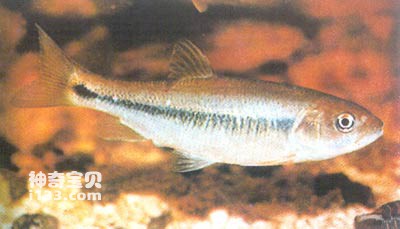Candidia barbatus belongs to the order Cypriniformes, family Cyprinidae, ("fish" on the left, "dan" on the right) subfamily, and the genus Candidia barbatus. Commonly known as: Taiwanese horsemouth, midday fish, mountain fish. English name: Lake candidus dace.
Endangerment level: Vulnerable.
The body is long, slightly tall, slightly flattened on the sides, raised behind the head, thin on the tail stalk, and round in the abdomen. The head is large and round. The muzzle is short, slightly broad, and slightly pointed at the end. The cleft of the mouth is wide, terminal, and slopes downward. The maxilla extends backward beyond the vertical line of the middle of the eye. There is an inconspicuous protrusion at the front of the mandible that matches the depression of the maxilla. The mouth has a pair of short whiskers. The eyes are small. The scales are fine, and the lateral line curves downward significantly above the pectoral fin, extends backward along the lower part of the body, and gradually rises behind the anal fin to the middle of the caudal peduncle. The dorsal fin is short and its origin is located behind the center of the body and behind the origin of the pelvic fin; the pectoral fin is long; the pelvic fin is short; the anal fin is well developed and can reach the base of the caudal fin; the caudal fin is deeply forked. The back is grey-brown, the abdomen is gray-white, and there are blue-black vertical stripes on the central axis of the body. The underside of the head, pectoral and pelvic fins and abdomen of the male fish during the reproductive period are all orange-red.

They live in the upper reaches of rivers and like to live in water bodies with clear water and low water temperatures. Even in the same river, there are very few similar fish species of the genus Lepidus. They swim quickly, jump well, and are gluttonous. They can even change their body shape and become extremely obese. It is a small omnivorous fish.
This species is endemic to Taiwan Province and is distributed in the upper or middle reaches of rivers in western Taiwan Province. The distribution area is narrow and the population is small. Due to the construction of dams or reservoirs in the upper reaches of some rivers in the distribution area, the hydrology has changed, the feeding and reproduction of fish have been affected, and the current population size has been significantly reduced.
animal tags:
We created this article in conjunction with AI technology, then made sure it was fact-checked and edited by a Animals Top editor.